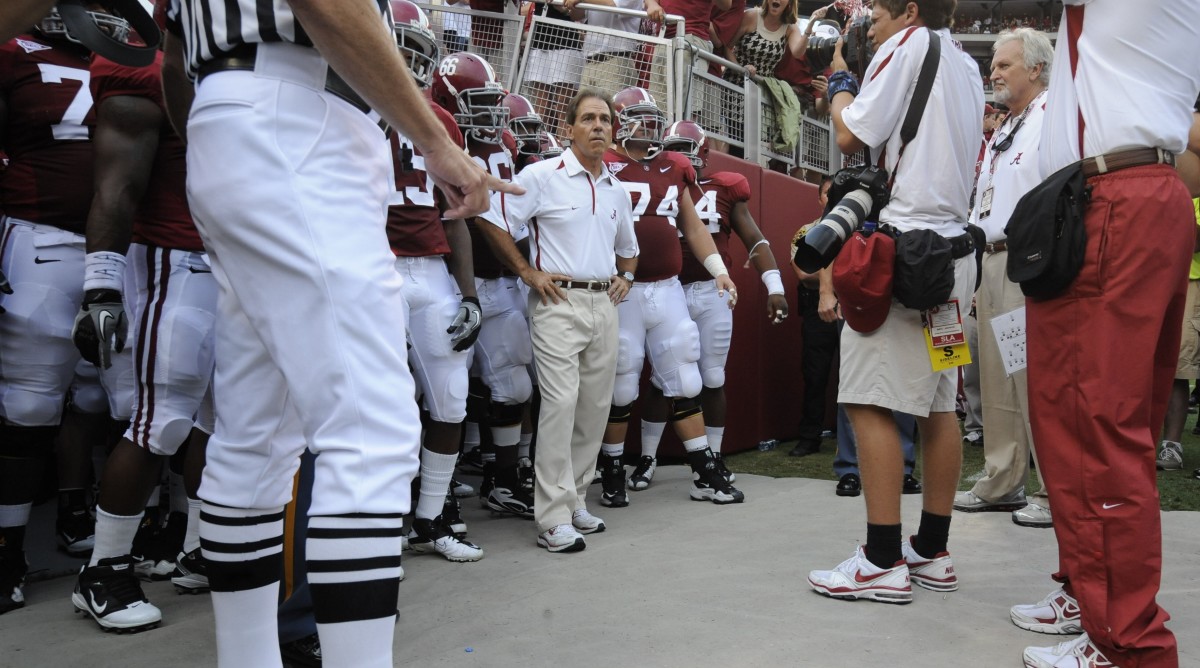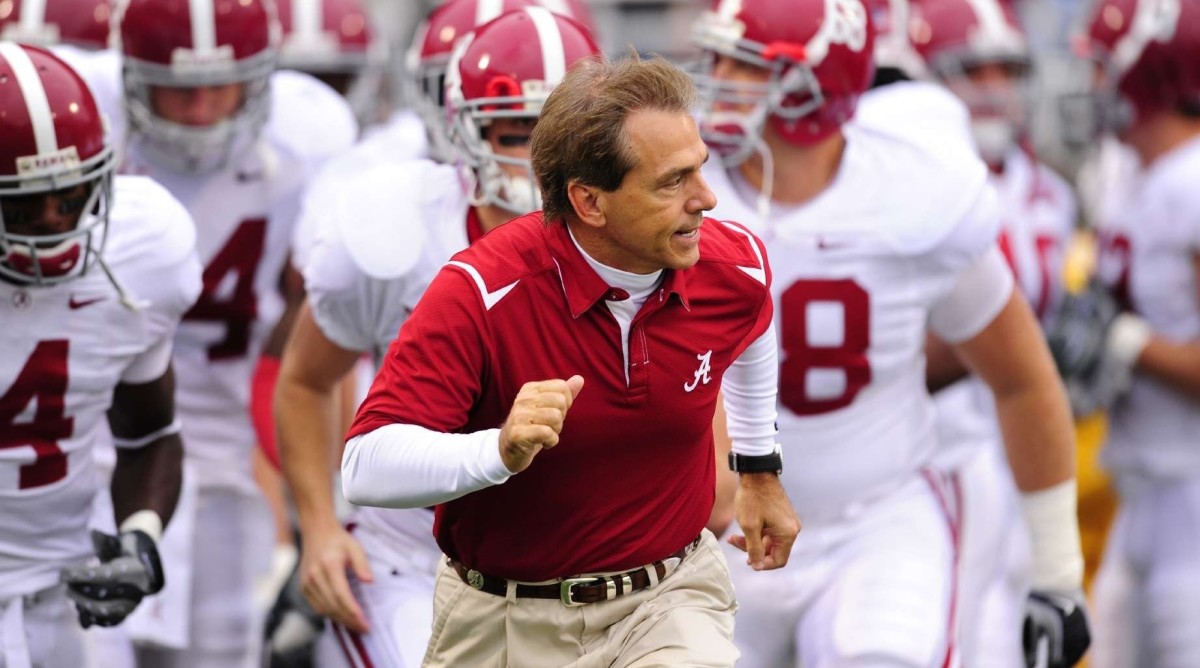Nick Saban’s Revolutionary Impact on Football Will Linger Long After His Retirement

The greatest testament to Nick Saban is not his championships nor his Iron Bowl victories. It isn’t his players who have gotten drafted in the NFL or his No. 1 recruiting classes. It is the fact you cannot tell the story of modern football without mentioning his name. Many coaches win, but few fundamentally alter the way the sport is played.
It all started in 1995 because he had a problem.
At the time, Saban was the defensive coordinator of the Cleveland Browns under Bill Belichick, and they’d just flamed out in the playoffs to the Pittsburgh Steelers. Of the Browns’ six losses that season (including the postseason loss), the Steelers delivered three of them because they presented a unique issue for Saban’s defense.
The Browns couldn’t play a coverage with multiple deep safeties because that didn’t allow them enough bodies in the box to stop the run. When Cleveland played Cover 3 (zone defense with three defensive backs deep and players attempting to break on the ball when it was thrown), Pittsburgh would shred the Browns with four vertical routes that outnumbered them down the field, and as Saban quipped once in a coaching clinic “when Dan Marino is throwing it, that old break on the ball s--- don’t work.” When they tried to play straight man coverage, the Steelers receivers were too good for them to match up mano a mano.
So Saban hybridized his system. Saban likes to say his defenses play zone, man, and zone or man-to-man match coverages. He and Belichick implemented and then popularized a defense that effectively played Cover 1 and Cover 3 at the same time and could keep eight men in the box to stop the run. In the match coverage world Saban ushered into existence, defenders drop to a zone then take responsibility for a receiver after their pass patterns distribute them across the field. It even has its own language. “Cover 7”, “rat in the hole”, “rip/liz.” Malleability is at the core of how his beautiful football mind works.

There are times when schematic innovators do not reach the mountaintop. It is often up to those who come after to build upon the innovation and carry it further. Bill Yeoman created the triple option, and Nebraska built a dynasty on it. Don Coryell changed the passing game forever in the 1970s, but never coached in a Super Bowl. Mouse Davis brought the run n’ shoot passing game to the NFL in the ’80s, but the Patriots used its intricate option routes to win Super Bowls in the 2000s. Saban never stopped summiting, or at least getting close to it with six national titles at Alabama. He ends his career during what passes for a title drought for him—three years without a title, the longest he’s ever gone without one with the Crimson Tide. Every Saban recruiting class except his last two at Alabama played for a national championship within four years. Even the 2023 team, regarded as one of his weakest since his run of dominance began, got to overtime of the semifinal in Saban’s last season.
He persisted as he changed the game, and then the game changed around him so he followed those trends, too. He brought someone in who, personality wise, he was oil and water with in Lane Kiffin to help usher his Tide into a new era of offense in 2014. Saban’s first stanza in Tuscaloosa was defined by his defense smashing all comers and controlling the clock and the game. But even he couldn’t ignore that up-tempo offenses that threw more on average, packaged multiple plays in one (run-pass options) and fundamentally altered the way the game was played.
“We were sort of a running team first, play-action passes, try to make explosive plays in the passing game a different way, but you know as the game evolved, RPOs became very prominent, and you say we need to implement some of these things or we’re not really taking advantage of the rules of college football,” Saban said in a 2019 interview with ESPN.
In this way, he is reminiscent of the only coach in Alabama or the history of college football, who can be mentioned in the same breath as him: Bear Bryant. Bryant switched to the wishbone after a few barren years and won three national championships as his career wound down. Saban’s newfound openness on offense also produced three titles and three more berths in the title game. But he also saw the way the pendulum was swinging back. In an interview with Sports Illustrated in August, Saban spoke about the way some offenses had started to get heavier with their personnel, and essentially laid out the blueprint for how Michigan returned to glory.
“You look at some of the more successful teams, they have gotten back to not being in [the] spread all the time, more tight ends involved in the offense, more balance in the run game and play-action passes—not just spread RPOs and dropback passes,” Saban said. “I think that there has been a little bit of a shift because the defense sorta shifts to adapt to what the offense is doing so even in the type of personnel that you have.
“When you play [against the] spread, you have to have more athletic linebackers. They’re not as big sometimes, guys that can take on people up front, so now you go back to running the ball when you’re playing with those guys and you create a little advantage for yourself. Football is always going to evolve. When people adapt to one thing, they’re either gonna invent something else, or revert back to something that happened in the past that we now take advantage of how you’ve adapted to stop something new.”

Saban’s organizational structure is often imitated and rarely duplicated. Nearly half of the current SEC programs, as well as Texas, have hired former Saban assistants. In all, 26 Saban assistants have gone on to be head coaches. Only three (Jimbo Fisher, Steve Sarkisian and Kirby Smart) beat him. He is 31–3 all-time against them, including the last win of his career over Smart. He had eight offensive coordinators, and myriad position coaches who left, and yet the winning continued because he was at the top of the food chain. Former coaches, like Butch Jones, Mike Stoops, Sarkisian, Mike Locksley and Charlie Strong, flocked to be analysts under him to gain some insight into how the Bama machine worked on and off the field.
And there is also Saban’s obsession with human psychology and behavior. The famed process, which he developed after a conversation with a psychiatrist while he was the coach of Michigan State in the late-1990s, demands Saban’s players to treat every play with a life of its own and to not focus on the outcome, but rather attempt to break things down to basics so that they can have the chance to be successful. In the process, Saban attempts every day to defy human nature and ignore external factors that contribute to self-gratification. The basic need to survive, in Saban’s world, holds people back from their true potential.
It’s why there was never going to be a retirement tour. That would mean Saban would have to take some time to smell the roses and shift gears down. It would invite inconsistency, which he is anathema to. There is no Bobby Bowden long goodbye in which he suffered the indignity of six-loss seasons and unranked finishes. There isn’t even a final year like Bryant’s in which Alabama suffered the indignity of losing multiple winning streaks against hated rivals Auburn, Tennessee and LSU and a 57-game win streak in Tuscaloosa at the hands of Southern Miss. Saban is perpetual, even to his last day in charge when he participated in an SEC coaches’ Zoom call.
The Saban chapter of college football’s long history is over, and what an epic it was until the very end.
